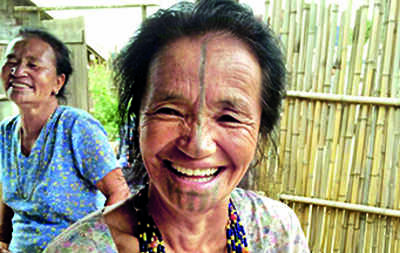- News
- City News
- guwahati News
- Stigma forcing Apatanis to discard nose plugs, face tattoos: IIT-Guwahati study
Stigma forcing Apatanis to discard nose plugs, face tattoos: IIT-Guwahati study

Guwahati: The popular practice of the use of large nose plugs (yapin) and facial tattoos (tipe) by the Apatani tribe in Arunachal Pradesh, which dates back to ancient days, is on the verge of extinction mostly because of stigma faced by the locals, said a study by IIT Guwahati researchers.
The study, published this month in Asian Journal of Social Science, has brought to light that the tradition is dying out more because of the stigma faced by the Apatanis. It seemed that youths found it irrelevant and painful but the research found that underlying events — stigma accompanied by acculturation and modernisation — have had a hand in bringing the changes in the mindset of the Apatanis, one of the 26 tribes in Arunachal Pradesh.
According to a narrative, these physical modifications resulting in “imposed ugliness” were made so that the men of a “neighbouring tribe” would no longer raid their villages and kidnap the women of the tribe settled in Ziro valley, known for Apatani cultural landscape. The researchers — Tania Sen, Sambit Mallick and Ngamjahao Kipgen — noted that the desire for modernity and progress played an important part in the decision to do away with tradition.
The researchers said such incidents of stereotyping, ethnocentrism and stigma can have several impacts on the psycho-social well-being of an individual as is evident in these cases. “Stigma played an essential role when it came to the ban of tipe,” said Mallick.
In 1971, the Apatani Youth Association (AYA) strived to bring changes in the valley for the betterment of fellow tribesmen, which also included a ban on facial tattoos and nose plugs. The AYA even imposed a fine of one mithun (Bos frantalis) or Rs 10,000 on those still practising tipe, the research revealed.
The first president of AYA, Dr Dure, himself mentioned instances when he was ashamed of his tipe. He stood first in his class during his studies in Kolkata and while he went up to the stage to collect his award, he overheard some of his college mates making fun of him”
“It did not feel good. I felt humiliated and at the same time I felt like I did not belong there,” he said. So after completing his education, he decided to get rid of his tipe by surgery.
In a state where entry of “outsiders” is protected through the inner line permit system, the tribesmen said at the entry posts, their tipe was like an identity card. But whenever “outsiders” came to the valley, Kani, a fellow villager, said she would invariably be asked the most irritating question. “Why do you have the mark? Is it mandatory?” When Kani went to Lakhimpur district in Assam, people stared at here like she was an alien.
The study, published this month in Asian Journal of Social Science, has brought to light that the tradition is dying out more because of the stigma faced by the Apatanis. It seemed that youths found it irrelevant and painful but the research found that underlying events — stigma accompanied by acculturation and modernisation — have had a hand in bringing the changes in the mindset of the Apatanis, one of the 26 tribes in Arunachal Pradesh.
According to a narrative, these physical modifications resulting in “imposed ugliness” were made so that the men of a “neighbouring tribe” would no longer raid their villages and kidnap the women of the tribe settled in Ziro valley, known for Apatani cultural landscape. The researchers — Tania Sen, Sambit Mallick and Ngamjahao Kipgen — noted that the desire for modernity and progress played an important part in the decision to do away with tradition.
The researchers said such incidents of stereotyping, ethnocentrism and stigma can have several impacts on the psycho-social well-being of an individual as is evident in these cases. “Stigma played an essential role when it came to the ban of tipe,” said Mallick.
In 1971, the Apatani Youth Association (AYA) strived to bring changes in the valley for the betterment of fellow tribesmen, which also included a ban on facial tattoos and nose plugs. The AYA even imposed a fine of one mithun (Bos frantalis) or Rs 10,000 on those still practising tipe, the research revealed.
The first president of AYA, Dr Dure, himself mentioned instances when he was ashamed of his tipe. He stood first in his class during his studies in Kolkata and while he went up to the stage to collect his award, he overheard some of his college mates making fun of him”
“It did not feel good. I felt humiliated and at the same time I felt like I did not belong there,” he said. So after completing his education, he decided to get rid of his tipe by surgery.
In a state where entry of “outsiders” is protected through the inner line permit system, the tribesmen said at the entry posts, their tipe was like an identity card. But whenever “outsiders” came to the valley, Kani, a fellow villager, said she would invariably be asked the most irritating question. “Why do you have the mark? Is it mandatory?” When Kani went to Lakhimpur district in Assam, people stared at here like she was an alien.
FOLLOW US ON SOCIAL MEDIA
FacebookTwitterInstagramKOO APPYOUTUBE
Start a Conversation
end of article










